DATE AND TIME SET
It is necessary to set the date and time for the unit every time batteries are
initially installed or replaced.
1. Load 4 AAA alkaline batteries; the YEAR will flash on the display.
2. Press the USER M1/ + button to advance the display to the desired year.
Press the USER M2/ button to confirm the year.
3. Next, the MONTH will blink. Repeat step 2 to set the MONTH and DATE, then
HOURS, then MINUTES.
DISPLAY EXPLANATIONS
: Appears for User 1
: Appears for User 2
AVG
Memory Average: Displays average of last 3 readings.
Pulse Symbol: Shows the heart rate per minute.
WHO Risk Category Indicator: See Blood Pressure Standard section.
Low Battery Symbol: Appears when batteries should be replaced.
Irregular Heartbeat Detector: See below for more information.
: Appears when cu inflates
: Appears when cu deflates
IRREGULAR HEARTBEAT DETECTOR
The appearance of the icon indicates that a pulse irregularity consistent
with an irregular heartbeat was detected during
measurement. Usually, this is not a cause
for concern. However, if the symbol appears
often, we recommend you seek medical advice.
Please note that the device does not replace a
cardiac examination, but serves to detect pulse
irregularities at an early stage.
Movement, shaking, or talking during the
measurement can result in pulse irregularities that may cause the appearance
of this icon. Therefore, it is of great importance to not move or talk during
measurement.
To determine the presence of an irregular heartbeat, the average of the
heartbeat intervals is calculated with the first 3 normal eective heartbeat
values. It is important to note that the average is not a strict mathematical
averaging of all recorded intervals. At least 3 beats with 25% or greater
dierence from the average heartbeat interval will generate the icon on
the screen.
BPA-O300
INSTRUCTION MANUAL
IMPORTANT PRODUCT NOTICES
AND SAFETY INSTRUCTIONS
When using your blood pressure monitor, basic precautions should always be
followed. Please read and follow all instructions and warnings before using this
product. Save these instructions for future reference.
• Please note that this is a home healthcare product only and it is not intended
to serve as a substitute for the advice of a physician or medical professional.
• This device uses oscillemetric method to measure systolic and diastolic blood
pressure, as well as heart rate.
• Do not use this device for diagnosis or treatment of any health problem or
disease. Measurement results are for reference only. Consult a healthcare
professional for interpretation of pressure measurements. Contact your
physician if you have or suspect any medical problem. Do not change your
medications without the advice of your physician or healthcare professional.
• Proper cu size is critical for accurate measurements. Follow the instructions
in this manual and printed on the arm cu to ensure the arm cu is used
properly.
• This product is not suitable for people with arrhythmias. This device may have
diculty determining the proper blood pressure for pregnant women and for
users with irregular heartbeat, diabetes, poor circulation of blood, kidney
problems, or for users who have suered a stroke.
• Excessive use may result in blood flow interference, which is likely to cause
uncomfortable sensations, such as partial subcutaneous hemorrhage, or
temporary numbness to your arm. In general, these symptoms should not last
long. However, if you do not recover in time, please seek advice from a medical
professional.
• The pulse display is not suitable for checking the frequency of heart
pacemakers.
• Electromagnetic interference: The device contains sensitive electronic
components. Avoid strong electrical or electromagnetic fields in the direct
vicinity of the device (e.g., mobile telephones, microwave ovens). These may
lead to temporary impairment of measurement accuracy.
• Please use this device indoors only.
• Use blood pressure monitor only for its intended use.
• Do not wrap the cu around body parts other than your arm.
• Not for use by or on persons under the age of 18.
• Do not use this device on infants, children, or those who cannot express their
own intention.
• Please use only the 1.5V AAA alkaline batteries for power supply.
Blood pressure measurements determined with this device are equivalent to
those obtained by a trained observer using the cu/stethoscope auscultatory
method within the accuracy limits prescribed by the American National Standard
for manual, electronic, or automated sphygmomanometers.
ABOUT BLOOD PRESSURE
What is blood pressure?
Blood pressure is the pressure exerted on the artery walls while blood flows
through the arteries. The pressure measured when the heart contracts and
sends blood out of the heart is systolic (highest) blood pressure. The pressure
measured when the heart dilates with blood flowing back into the heart is called
diastolic (lowest) blood pressure.
Why measure your blood pressure?
Among today’s various health problems, those associated with high blood
pressure are very common. High blood pressure dangerously correlates with
cardiovascular diseases. Therefore, blood pressure monitoring is important for
identifying those at risk.
Why do my readings vary?
Blood pressure is a body parameter that is subject to normal variations
throughout the day. A single reading that is dierent from your and your doctor’s
readings are not necessarily inaccurate. The average of several readings, taken
under similar conditions, using the same arm, is preferred for accurate blood
pressure readings.
Why are my readings dierent than those taken at my doctor’s oce?
Many experience a phenomenon called “White Coat Hypertension” when
measured by a doctor. White Coat Hypertension refers to blood pressure that rises
above its usual level when measured in a clinical setting, such as a doctor’s oce.
BLOOD PRESSURE STANDARD
The table below contains defined levels of hypertension from the World Health
Organization (WHO). The WHO has established globally accepted standards from the
assessment for high blood pressure readings. Users can compare their own blood
pressure readings against these defined levels to determine if they may potentially be
at increased risk. This table is applicable to most adults age 18 and older.
mmHg
110
100
90
85
80
Diastolic Blood Pressure
Hypertension
Indicator
Systolic Blood Pressure
*Source: World Health Organization (WHO)
120 130 140 160 180 mmHg
Severe Hypertension (Grade 3) -Red
Moderate Hypertension (Grade 2) -Orange
Mild Hypertension (Grade 1) -Yellow
High-Normal -Green
Normal -Green
Optimal -Green
Blood pressure tends to go up and down, even in people who normally don’t have
high readings. If your numbers stay above the “normal” range most of the time,
you may be at increased risk and should consult your physician.
Although one can easily find where their own blood pressure readings fall
on this table, this monitor comes equipped with a Risk Category Index that
automatically compares each reading to the defined levels and provides a helpful
cue if your reading falls into one of the stages that could potentially indicate an
increased risk.
Please note that cues provided by this monitor are only intended to assist you
in using this table. The table and cues are only provided for convenience to help
you understand your non-invasive blood pressure reading as it relates to the
WHO information. They are not a substitute for a medical examination by your
physician. It is important for you to consult with your physician regularly. Your
physician will tell you your normal blood pressure range as well as the point at
which you may actually be considered to be at risk.
NOTE: This blood pressure
monitor uses defined levels for
hypertension from World Health
Organization (WHO). This table
provides the American Heart
Association blood pressure
guidelines (AHA 2017) for your
reference. You can compare
your readings to this chart to
know where your measurement
falls according to the AHA 2017
defined levels for hypertension.
Blood Pressure
Category
Sistolic mmHg
(upper number)
Diastolic mmHg
(lower number)
Normal Less than 120 and Less than 80
Elevated 120 – 129 and Less than 80
High Blood Pressure
(Hypertension)
Stage 1
130 – 139 or 80 – 89
High Blood Pressure
(Hypertension)
Stage 2
140 or higher or 90 or higher
Hypertension Crisis Higher than 180 and/or Higher than 120
*Source: AHA 2017
NAME/FUNCTION OF EACH PART
BATTERY INSTALLATION
1. Press down on the latch and lift the battery cover to open.
2. Install or replace 4 AAA alkaline batteries in the battery compartment. Make
sure the polarities “+” and “-” ends coincide with similar markings inside the
compartment.
3. Close the battery cover by pushing in the top end of the battery door.
Replace the batteries if:
• The low battery symbol appears on the display.
• Nothing appears on the display when the
power is switched on.
NOTE:
• Date and time must be reset if batteries are
removed or replaced.
• Replace all batteries at one time (as
simultaneous set). Use only 1.5V AAA alkaline
batteries.
• When the batteries are removed, the measurement values stored in memory
are retained.
• Clean contacts on battery and in battery compartment with a soft, dry cloth
each time you install batteries.
• Batteries are hazardous waste. Do not dispose of them together with
household garbage.
End of Cu
D-Ring
USING THE ARM CUFF
1. If the cu is not assembled, pass the end of
the cu farthest away from the tubing
through the metal D-ring in order to form a
loop. The smooth side without the felt
material should be on the inside of the loop.
2. Plug the cu tube into the left side of
the unit.
3. Place the upper arm cu approx. ¾” – 1 ¼”
above elbow. Pull the end of the cu so
that it tightens evenly around your arm.
Press the hook and loop material together
to secure. There should be room for 2
fingers to be placed between the cu and
arm. Center tube over the middle of the arm.
Please note:
To use the right arm, you must position the artery symbol “ ” over the main
artery. Locate the main artery by pressing with 2 fingers approximately 1” (2cm)
above the bend of your elbow on the inside of your right arm. Identify where the
pulse can be felt the strongest. This is your main artery.
MEASUREMENT PROCEDURE
IMPORTANT:
DURING MEASUREMENT
• Do not talk or move your arm or hand muscles.
• Do not cross your legs. Sit with feet flat on the floor.
• Do not touch cu or monitor during measurement.
1. Press POWER button to turn the monitor ON. The display will perform a self-
test, then the values from the last reading will appear on the display.
2. The blood pressure monitor will start to measure. The cu will automatically
begin to inflate, with the display showing the increasing pressure in the cu.
As the pressure increases, an arrow pointing up will appear on the display.
3. When the inflation has reached optimum level, the display will begin to show
decreasing pressure and an arrow pointing down will appear.
4. To detect the heartbeat, the heart symbol will appear and continuously flash
on the LCD display.
5. Your blood pressure measurement and pulse will display simultaneously on
the screen.
6. Press the M1 button to record the measurement into the MEMORY Recall
Button M1.
7. Press the M2 button to record the measurement into the MEMORY Recall
Button M2.
NOTE:
• This monitor automatically turns o approximately 2 minutes after last
operation. You may also press the POWER button to turn the unit o and
record the measurement result in to the MEMORY Recall M1.
• To interrupt the measurement, you may press the POWER button. The cu will
deflate immediately after a button is pressed.
Insert Plug
Here
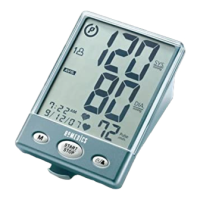
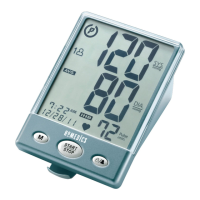
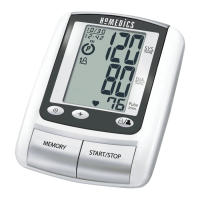
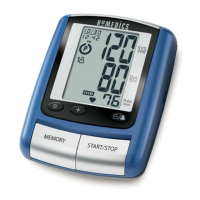
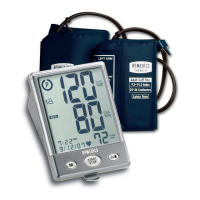

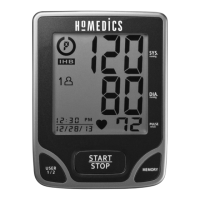


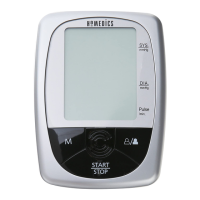

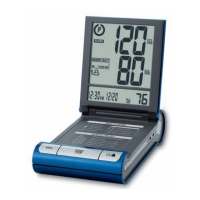
